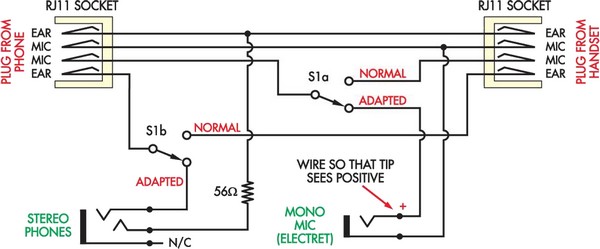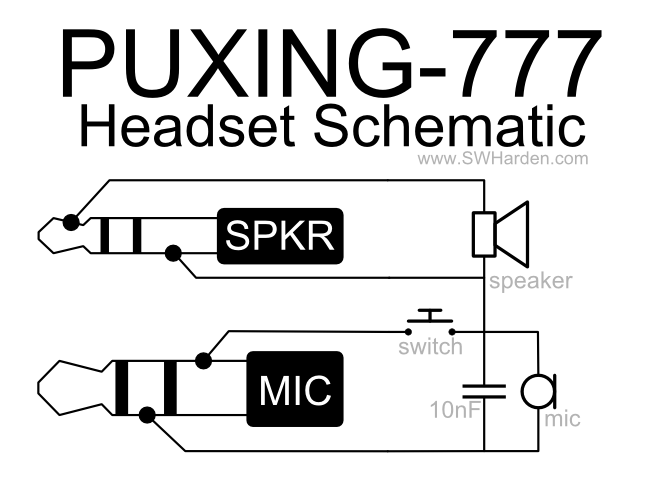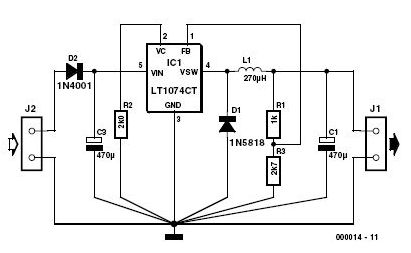
Cheapskates Headset Adapter

Here is a more affordable and simpler method to create a telephone headset adapter. The only components needed are an inexpensive headset (available for $5 at Harvey Norman), a DPDT switch, and...
To construct a telephone headset adapter using the specified components, the process begins with selecting a suitable inexpensive headset that includes both a microphone and earpiece. The DPDT (Double Pole Double Throw) switch is a critical component in this setup, as it allows for the switching of audio signals between the headset and the telephone system.
The first step involves disassembling the headset to access its internal wiring. Identify the connections for the microphone and the earpiece. Typically, the headset will have two wires for the earpiece (left and right channels) and one wire for the microphone. These wires must be carefully soldered to the appropriate terminals on the DPDT switch.
The DPDT switch has six terminals, which can be utilized to route the audio signals. The first two terminals will connect to the microphone input of the telephone, while the next two will connect to the earpiece. The remaining terminals will serve as the output connections from the telephone to the headset. By toggling the switch, the user can alternate between using the telephone's built-in audio and the headset audio.
Once all connections are made, it is essential to ensure that the switch is mounted securely and that the wiring is insulated to prevent any short circuits. A small enclosure can be used to house the switch and wiring, providing protection and a professional appearance.
Testing the completed adapter involves plugging it into a telephone and ensuring that both the microphone and earpiece function correctly. Adjustments may be needed if there are issues with audio quality or connectivity.
This method offers a cost-effective solution for individuals seeking to utilize a headset with a telephone, making it accessible for a variety of applications, including teleconferencing and personal use.Here s a cheaper and easier method of making a telephone headset adapter. All that s required is a cheap headset ($5 at Harvey Norman), a DPDT switch and.. 🔗 External reference
To construct a telephone headset adapter using the specified components, the process begins with selecting a suitable inexpensive headset that includes both a microphone and earpiece. The DPDT (Double Pole Double Throw) switch is a critical component in this setup, as it allows for the switching of audio signals between the headset and the telephone system.
The first step involves disassembling the headset to access its internal wiring. Identify the connections for the microphone and the earpiece. Typically, the headset will have two wires for the earpiece (left and right channels) and one wire for the microphone. These wires must be carefully soldered to the appropriate terminals on the DPDT switch.
The DPDT switch has six terminals, which can be utilized to route the audio signals. The first two terminals will connect to the microphone input of the telephone, while the next two will connect to the earpiece. The remaining terminals will serve as the output connections from the telephone to the headset. By toggling the switch, the user can alternate between using the telephone's built-in audio and the headset audio.
Once all connections are made, it is essential to ensure that the switch is mounted securely and that the wiring is insulated to prevent any short circuits. A small enclosure can be used to house the switch and wiring, providing protection and a professional appearance.
Testing the completed adapter involves plugging it into a telephone and ensuring that both the microphone and earpiece function correctly. Adjustments may be needed if there are issues with audio quality or connectivity.
This method offers a cost-effective solution for individuals seeking to utilize a headset with a telephone, making it accessible for a variety of applications, including teleconferencing and personal use.Here s a cheaper and easier method of making a telephone headset adapter. All that s required is a cheap headset ($5 at Harvey Norman), a DPDT switch and.. 🔗 External reference





